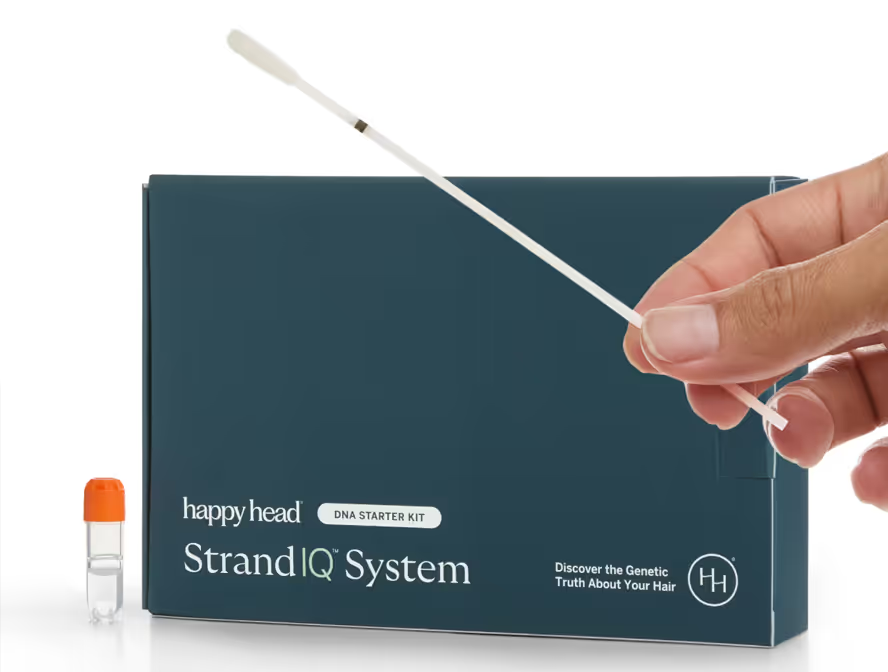Finasteride is a trusted option for treating male and female pattern hair loss. It works by reducing DHT, a hormone that weakens and shrinks hair follicles over time. With lower DHT levels in the scalp, finasteride can slow hair loss, help maintain fullness, and in some cases, promote noticeable regrowth.
However, the effectiveness of finasteride isn’t determined solely by the dose you take—it’s also shaped by how your body processes the drug. Your genetic profile plays a key role in this process, particularly through variations in liver enzymes that metabolize finasteride. Happy Head’s StrandIQ™ analysis helps you to understand your unique metabolism rate, helping you and your healthcare provider to make more informed treatment decisions.
Genetics and Finasteride Metabolism
Finasteride is primarily metabolized in the liver by enzymes in the cytochrome P450 family, especially CYP3A4 and CYP3A5. Variations in these genes can cause:
- Rapid metabolism – Your body breaks down finasteride quickly, leading to lower drug levels in the bloodstream and reduced DHT suppression.
- Slow metabolism – Your body processes finasteride more slowly, which can increase drug exposure and the potential for side effects.
Genetic variants in drug transporter genes may also influence how much finasteride reaches target tissues like the scalp. Combining these factors gives a clearer picture of your likely response and side effect risk.
Metabolization Levels and What They Mean
- Fast or Normal Metabolizer – Your genetics suggest you break down finasteride quickly, which may sometimes reduce its effectiveness at standard dosing.
- Moderate Metabolizer – You process finasteride at a typical rate—standard 1 mg daily dosing should be effective for DHT suppression.
- Slow Metabolizer – Your genetic profile indicates slower metabolism, potentially increasing exposure and risk of side effects with standard dosing.
Fast or Normal Metabolizer – Ensuring Effective Coverage
If your Happy Head StrandIQ™ report shows that you process finasteride more quickly than average, the medication may leave your system sooner, potentially reducing its DHT-blocking benefits.
- Adjust dosing schedule
Consider split dosing (e.g., 0.5 mg twice daily) or slightly increasing the dose under healthcare supervision to maintain steady drug levels. - Track effectiveness
Monitor hair density and DHT levels to confirm sustained suppression. - Support with additional treatments
Adding topical minoxidil, microneedling, or low-level laser therapy can help offset reduced oral efficacy.
Moderate Metabolizer – Stick with Standard Protocol
If your StrandIQ™ analysis indicates a moderate impact on finasteride effectiveness, strategic adjustments can help improve outcomes.
- Use standard 1 mg daily dosing
Your metabolism should allow steady drug levels with good tolerance. - Evaluate progress periodically
Track regrowth and side effects every 3–6 months to confirm benefits and safety. - Augment as needed
Combining finasteride with healthy habits—like eating a nutrient-rich diet and managing stress—should help you get the best results.
Slow Metabolizer – Reducing Side-Effect Risk
If your StrandIQ™ analysis indicates reduced finasteride metabolization, you’ll need a more customized plan.
- Consider a lower starting dose
Your Happy Head dermatologist may begin at 0.5 mg daily or use dosing every other day to minimize accumulation. - Watch for side effects
If you notice changes in libido, mood, or breast tenderness, tell your doctor right away so they can adjust your treatment if needed. - Explore alternatives if needed
If side effects limit use, consider topical finasteride or other hair regrowth options.
The Bottom Line
Understanding your finasteride metabolism profile empowers you and your physician to fine-tune treatment. Whether you're a fast, moderate, or slow metabolizer, aligning dose and frequency with your body's processing speed helps maximize regrowth potential while minimizing risks.
Resources
StrandIQ SNP Marker Count: 1
StrandIQ Genes for Trait:
CYP3A4
References:
Chau, C.H., et al. (2015). Finasteride concentrations and prostate cancer risk: results from the Prostate Cancer Prevention Trial. PLoS One, 10(5), e0126672. PMID: 25955319.
Elens, L., et al. (2013). CYP3A4*22: promising newly identified CYP3A4 variant allele for personalizing pharmacotherapy. Pharmacogenomics, 14(1), 47–62. PMID: 23252948.
Hulin-Curtis, S.L., et al. (2010). Finasteride metabolism and pharmacogenetics: new approaches to personalized prevention of prostate cancer. Future Oncology, 6(12), 1897–1913. PMID: 21142863.
Pratt, V.M., et al. (2023). CYP3A4 and CYP3A5 genotyping recommendations: A joint consensus recommendation of the Association for Molecular Pathology, Clinical Pharmacogenetics Implementation Consortium, College of American Pathologists, Dutch Pharmacogenetics Working Group of the Royal Dutch Pharmacists Association, European Society for Pharmacogenomics and Personalized Therapy, and Pharmacogenomics Knowledgebase. Journal of Molecular Diagnostics, 25(9), 619–629. PMID: 37419245.
Wang, D., Sadee, W. (2016). CYP3A4 intronic SNP rs35599367 (CYP3A4*22) alters RNA splicing. Pharmacogenetics and Genomics, 26(1), 40–43. PMID: 26488616.
This content, including StrandIQ™ DNA analysis reports and any Happy Head products and/or services referenced therein, is for informational and cosmetic purposes only. It is not intended to diagnose, treat, cure, or prevent any disease. This content does not constitute medical advice and should not be used to make healthcare decisions. References to prescription treatments are educational in nature. Always consult a licensed healthcare professional for any medical concerns or treatment decisions.








.avif)

